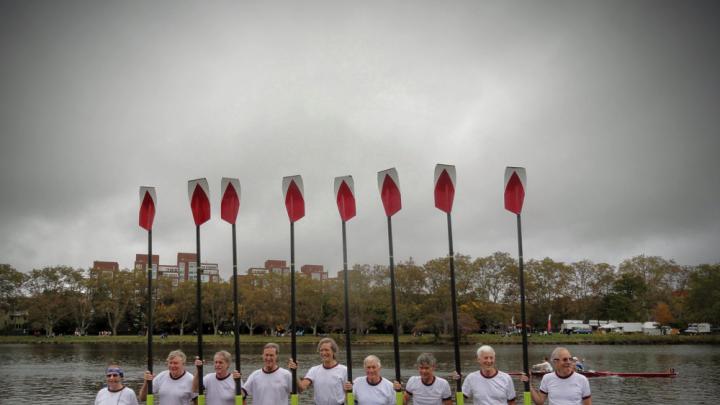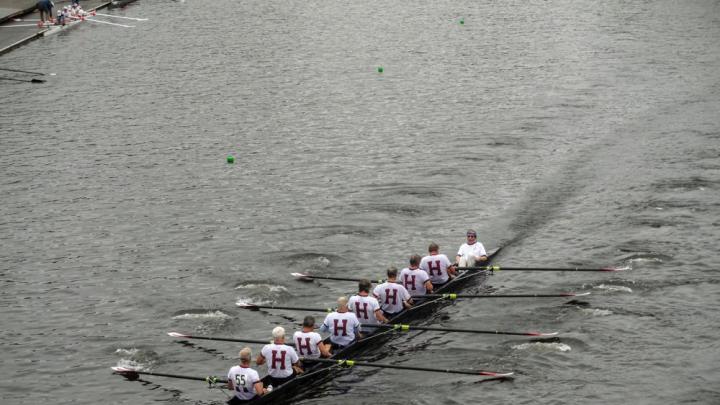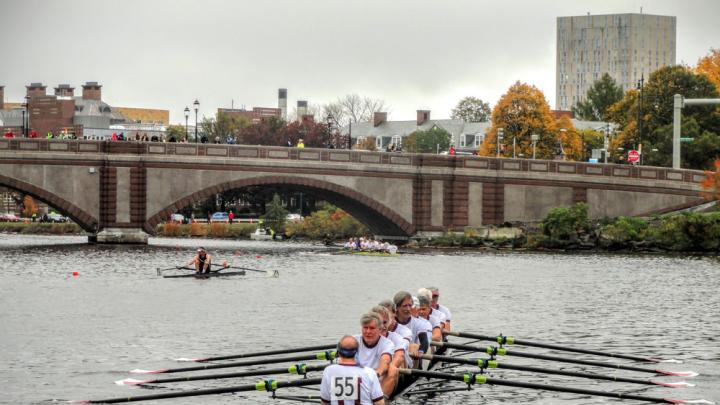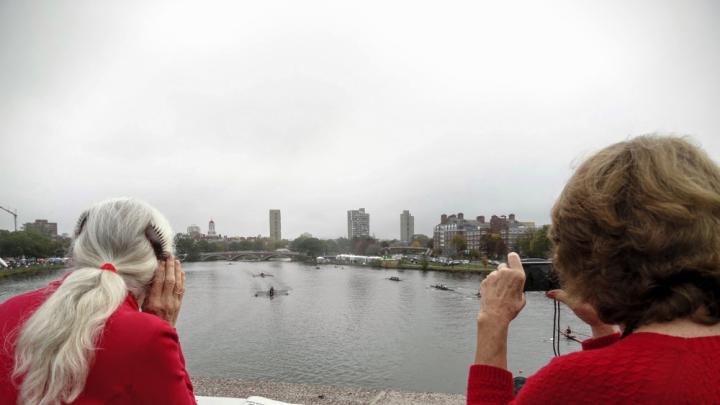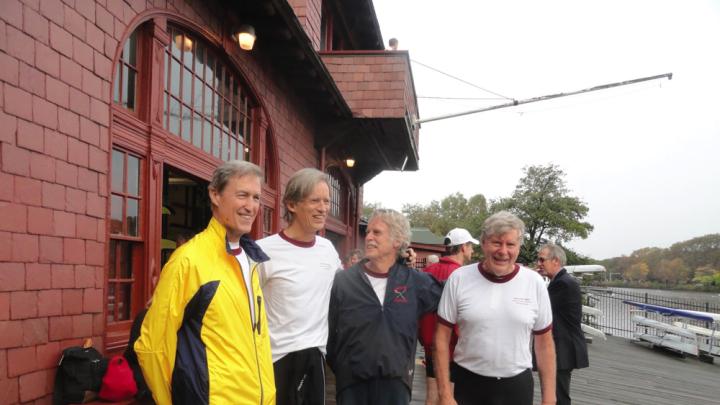For almost 50 years, this has been Garrett Olmsted’s recurring dream: “I’m back at Harvard,” said the former Crimson lightweight oarsman, “and I go down to the boathouse. And at first they don’t notice that I’m 30 or 40 or however old I am.” Olmsted ’68, Ph.D. ’76, starts getting his boat out. He checks the oars. He’s dressed and ready. But always, eventually, the others realize that he doesn’t belong there. “Most recently I had this dream three months ago. I’m 70, and I’m at the boathouse, and finally the coach realizes right before the first race, and he says, ‘You can’t row anymore—you’re 70 years old! You’ve got to get out of the boathouse!’”
But this past weekend, the 70-year-old Olmsted was once again stroking for Harvard. Rowing out of Newell Boathouse in a borrowed Harvard shell with crimson blades, he and eight former crewmates from the mid 1960s—all wearing T-shirts emblazoned with a giant H—joined the thousands of rowers competing in the Head of the Charles Regatta. For Olmsted’s crew, this race was special: it marked a half-century since the first time each of them had participated. Back in 1966, the Head of the Charles was barely begun—a modest little one-day contest along the banks of the river—and the men were juniors and seniors in college. Some kept rowing: Bobby Baker ’68 has raced in almost every Head since that first one; and Bill Endicott ’68, M.P.A. ’76, became not only a rower but an Olympic coach and athlete in canoe and kayak slalom. For others, it had been years, or maybe even decades, since they’d touched an oar to the water. Then last winter, they started getting calls from Olmsted.
There was no saying no. Gerry Goulet ’69 was coming off a December bout of pneumonia, bronchitis in January, and two broken ribs in February when Olmsted reached him. Olmsted said he was putting together an eight boat for the Head of the Charles. Could he count Goulet in? “I said, ‘Gee, Garrett, this has been a bit of a rough winter.’ And Garrett, who has more confidence in me and a lot of other people than the rest of us do, says, ‘Oh yeah, I’ve broken ribs before; don’t worry about it, no problem.’” Goulet asked for a little time to think about it. “Garrett says, ‘OK, I’ll be in touch.’” And he was. “Religiously, every month,” Goulet said, “I get this phone call: ‘Hey, how’re you doing! How’s those ribs going?’” Finally Goulet said yes. He bought an ergometer and started training.
For Olmsted, this race was about more than the anniversary, more even than a reunion with old teammates. For him, there was redemption in the return to the Charles River. “This race has become—well, I’m almost monomaniacal about it,” Olmsted said a few weeks ago, laughing though not really joking. Rowing has always been a singular passion. He is the son of an oarsman and the father of another, and he talks beamingly about his granddaughter, who just became a first-year rower at Exeter. In 1970, he and his late wife, Hope McGurdy Olmsted ’68, a rowing champion and varsity sailor, founded Radcliffe crew, the first women’s rowing program in the Ivy League.
But by the following year, he was no longer rowing himself. At 24, he’d broken his back in a tobogganing accident, not long after competing in the 1970 Head of the Charles. “Crushed a vertebra in the middle,” he says. He spent three months in the hospital, paralyzed from the waist down, and then another three months unable to roll over. His first question when he got out: “how am I going to row?” But rowing had become impossible. For a while he tried, but the pain was excruciating. He moved to southwestern Virginia, where he became a cattle farmer and professor of anthropology and sociology at the local college, Bluefield State, and took up hiking.
Then four years ago Olmsted went in for hip-replacement surgery and the doctors discovered that in the intervening decades, his vertebrae had fused and stabilized. He started rowing again as soon as his hip healed. His first big outing came in June 2015, in the alumni row at the 150th Harvard-Yale Regatta in New London, Connecticut. There he shared an eight boat with former Olympian Scott Steketee ’68 and with Endicott, with whom Olmsted had won a gold medal in the 1966 Head of the Charles. Steketee, a heavyweight rower, had been there too. (Endicott was at Red Top celebrating anniversaries of his own: one with his wife, Abbie Bingham Endicott, whom he’d met at the Harvard-Yale Race in 1964 and married the following year; and another with former Harvard rower Norm Bellingham ’93, M.B.A. ’98, whom Endicott had coached to a gold medal in kayaking in the 1988 Olympics.)
At the Harvard-Yale Regatta, Olmsted was back in his element, overjoyed. And emboldened: at one point that afternoon he tried chasing down a boatload of younger Yale alumni to challenge them to a race. (They declined, he said, by disappearing.) A month later he had purchased a single scull and begun training, with the idea of returning to the Head of the Charles. By the time he started making phone calls to the other guys, he was rowing two or three hours a day.
Endicott was among the first to sign on. Olmsted’s intensity was not unfamiliar. “I remember once back at Harvard, just before the race in the Eastern Sprints,” Endicott says, “Garrett was parading around with a bowie knife in his teeth. To show our opponents his determination.…I guess it worked, because we won.”
Olmsted also recruited Hugh Crane, the original coxswain from the Head-of-the-Charles run in 1966. He hadn’t been on the water in two decades, and after years of weightlifting he was a much bigger man than he’d been in college, when his race weight was never more than 120 pounds. Crane worked to drop more than 20 pounds so that on Saturday he could once again perch lightly in the stern. And Phil Tonks ’67, who’d recently retired from the wine-making business and taken up ocean sculling near his cottage in Maine. Tonks injured his knee skiing last winter but decided to put off surgery (and put up with some pain) until after the Head of the Charles was done. Goulet and Baker also joined up. And Gib Vincent ’67, who’d rowed up and down the Charles with Olmsted every day during the summer of 1967. Roger Cheever ’67, M.L.A. ’77, now Harvard’s associate vice president for principal gifts and alumni affairs and development, signed on too. And Steketee, who competed with the U.S. team in the 1968 Olympics. He was the only heavyweight in the boat. A bicycle racer, Steketee broke his hip last winter but elected to have it repaired rather than replaced. He was still on crutches when Olmsted called, and he couldn’t walk until April. Still, he said yes. The Head of the Charles would be a comeback for him, too.
“Everybody’s fighting through something,” Olmsted said a few weeks before the race. “But I love telling people I’m 70, because the last time I was in this good shape, I was 22. I think that’s the story for everybody.”
Before converging in Cambridge last week, they trained separately in single sculls and on ergometers, spread out across the East Coast: Vermont and Virginia, Buffalo and Philadelphia, suburban Rhode Island and Massachusetts. Six of the crewmates had spent a few days with the Endicotts in Connecticut, at Abbie Endicott’s family farm, where they rented boats and practiced rowing in pairs and fours. They started calling themselves the “buddies in the boat,” after The Boys in the Boat. (“We just want to make sure it’s not bodies in the boat,” Endicott joked.) Tonks had T-shirts made up for everyone.
Sitting around the kitchen table in Connecticut two days before the race, the men reminisced about old teammates and coaches and bygone regattas. They described what it was like to be together again, all these years later. Most were rowing the same positions they rowed as Harvard undergrads, including Olmsted, who at stroke, was the pacesetter for the boat. A human metronome, Tonks called him. “You can’t teach that.”
Olmsted recalled some of the races that had stayed with him over the years. The crashes in rough water, the come-from-behind wins. “If you ever want to see what rowing is all about,” he said, “look up Oxford Brookes versus Brown on YouTube.” It’s a video from the 2014 Henley Royal Regatta in Canada, in which Oxford Brookes runs away with the race. Their speed and power, under the roaring screams of the coxswain, are intense. “I’ve probably watched that video 50 times,” Olmsted said. “I cry when I see it. They’re so beautiful the way they’re rowing; they’re just perfect. Not one flaw, their blade work in the water—not one splash.”
Goulet picked up the thread. “The super lightweights from 1971,” he added, referring to a video of the Harvard Crew rowing at Red Top. “They have a whole sequence that one of the fathers must have taken, and—“
Olmsted: “It’s the same way, isn’t it?”
“The same way.”
“Just perfect.”
“Just. Perfect.”
For a moment, the table went quiet.
On the morning of the race, all nine men were together for the first time. There were handshakes and hugs and big smiles. Then they got down to business. They were to set off from the starting line at 9:50 a.m., in a heat with 61 other eight boats, among whom the average age was at least 50. Only one other crew, though, from the Occoquan Boat Club near Washington, D.C., had, like Olmsted’s men, an average age of 70. They were the competition.
The forecast for the Head of the Charles was bad weather, but early on Saturday a light drizzle flattened the water and the wind was calm. “Not too cold, not too warm—perfect,” Tonks said, looking out from the Newell Boathouse dock. A few minutes later, they lined up their oars and took down the long black racing shell they’d borrowed from Charley Butt, Bolles-Parker head coach of the men’s heavyweight crew. They carried the boat to the water, lowered it in, and climbed aboard in stockinged feet. Then, waving goodbye to wives, children, grandchildren, friends, and one fiancée, they rowed off toward the starting line. They didn’t look nervous. Their oars were turning in unison.
Not quite an hour later, the buddies in the boat came rowing back down the river, hauling their oars in and out of the water, pulling hard toward the finish line. They would cross it at 21:01.256, a minute behind the goal Olmsted had set and two minutes behind the Occoquan crew, but still victorious and elated (and, as Endicott pointed out, beating one younger boat). Abbie Endicott and Julie Tonks were watching from the Anderson Bridge when the men passed under it, scowling forward, arms churning. Julie Tonks looked at her husband as the boat sliced away. “Oh gosh,” she said. “I think we’re going to be back next year.”
